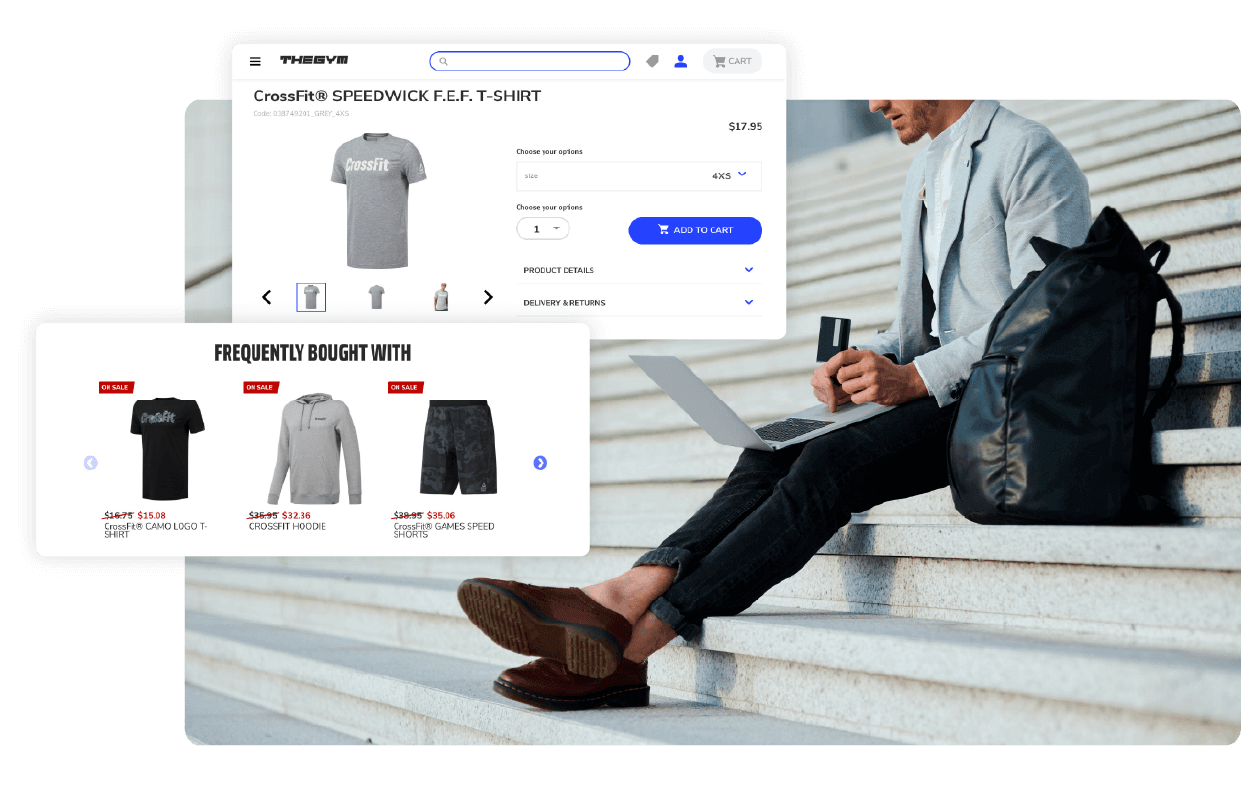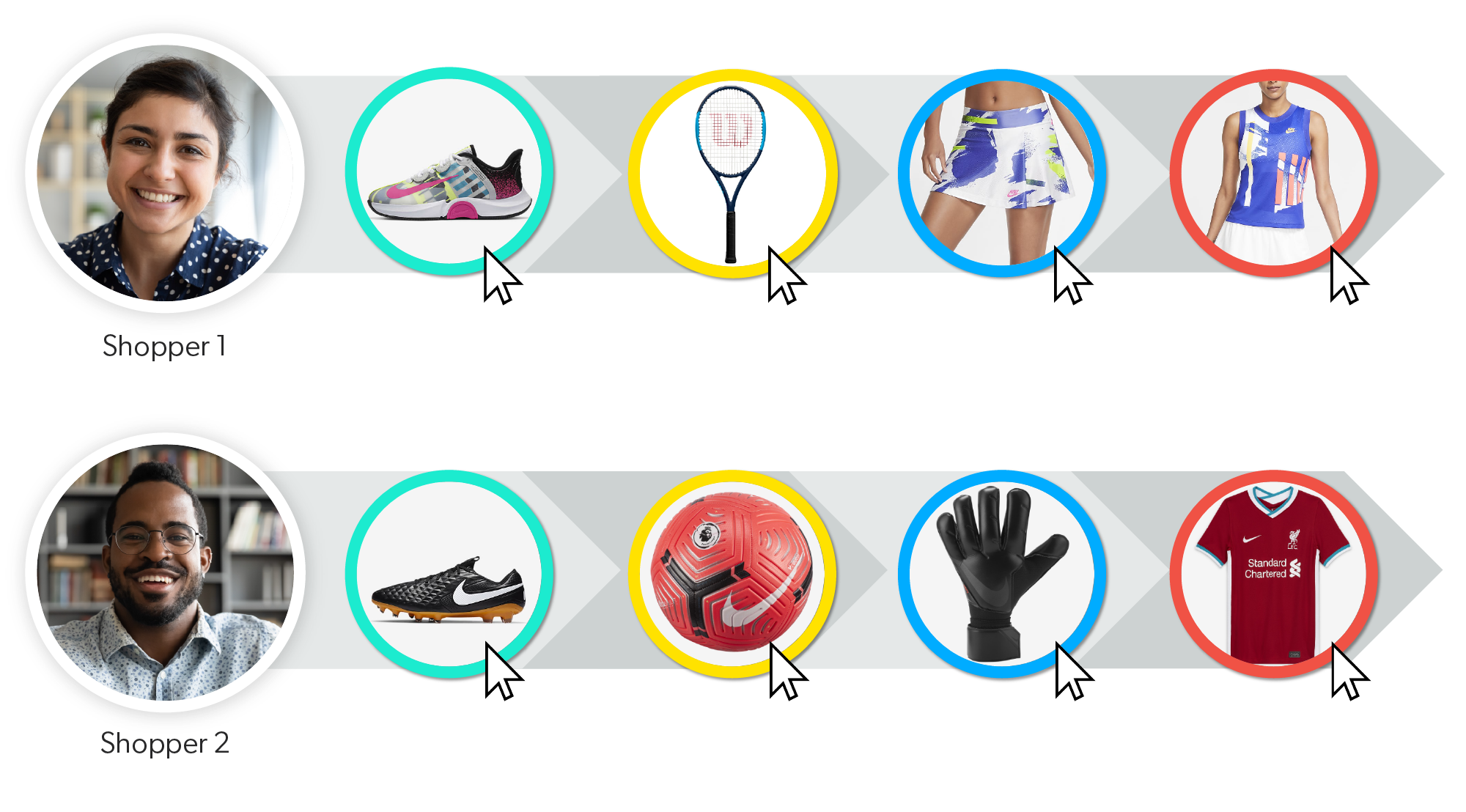Online stores are quickly becoming the primary retail channel for many. As a result, customer expectations for the digital and user experience you deliver have increased exponentially. Yet the mechanisms that could traditionally be used to compensate for the shortcomings of digital marketing have all but disappeared.
But there’s good news! Artificial intelligence and machine learning (ML) have given rise to powerful recommendation engines. These can help you meet those sky-high customer demands by providing highly personalized product recommendations. How exactly does a recommendation system do that?
By leveraging customer data and user behavior to anticipate what the visitor might need next. This allows you to develop an on-the-go personalization strategy.
Where to Include Personalized Product Recommendations in Ecommerce?
Ecommerce customer journeys have become increasingly complex, meaning that a recommendation engine can’t just focus on individual touchpoints anymore. In order to be effective, it must highly personalize every recommendation.
Established recommendation engines, such as Amazon and Netflix, personalize user experience based on past customer interactions. However, most ecommerce retailers don’t have the same percentage of registered users that Amazon and Netflix do. Requesting that a user create an account is actually a key driver of cart abandonment. Not all is lost. AI-powered recommendation engines like Coveo are designed to decode user behavior to develop recommendation strategies. Even for new and anonymous guests!

Product Recommendation Placements
There are many places where you can place the recommendation widget to deliver personalized product recommendations:
- Homepage recommendations: The homepage is the first thing that shoppers coming from direct traffic see when they visit a site. Relevant product recommendations on the homepage serve inform customers about the latest deals and discounts. It also showcases your product portfolio and personalized offerings. This is probably what you think of with Amazon or Netflix recommendations, because this is where they shine.
- Product page recommendations: A product page (or product information page) is where shoppers find detailed product descriptions, including its features. They can choose to add it to their cart or order it right away. The main goal of a product page recommendation is to suggest products that compel your visitor to continue browsing.
- Cart page recommendations: This is the place to recommend a related product to the one already in the user’s cart. Or a group of products or accessories frequently bought together.
- Product category recommendations: The number of choices a user can make on a product category page can be daunting. Facets and filters can be useful. But they aren’t much help if a shopper doesn’t quite know what it is that they need. Recommendations can guide them towards a relevant product, based on what you know about them up to that point.
Implementing Product Recommendations With Nuance
However, to effectively assist customers, it’s not enough to simply provide personalized product recommendations at different touch points. It’s important to acknowledge that different moments and touchpoints carry different expectations. Then you need to provide the most appropriate recommendations at each point. For instance, recommending a complementary product on the product page can at times be distracting to customers. Similarly, showcasing a trending product on the cart page — even based on expressed preference — might hinder the purchase.
The key is to provide the most relevant recommendation at every point in the customer journey. At some points during the journey, customers might benefit from content recommendations as well. A traditional view in ecommerce has been that content can act as a distraction and dilute the conversion funnel. However, this is not always true. Content can enhance decision-making and conversions as well as boost customer loyalty. This of course depends on where a customer is in their buying journey.
A good recommender system is based on an algorithm that blends content and product recommendation to enhance conversions. For example, ML-based recommendation engines can easily identify correlations in content consumed over the course of previous successful buyer journeys. If content compelled one person to make a purchase, it will likely compel others to do the same.
What are the Types of Personalized Product Recommendations?
Just as there are various places recommendations can be surfaced, there are also various different types of personalized product recommendations. Each type has a set of functions associated with it. Try to think about which of the following types would work best for you.

Consider the homepage recommendations use case described in the previous section. You can break these recommendations into a different types. Let’s explore this using Netflix:
- Personalized recommendation: The Netflix recommender system predicts what viewers would like to watch in the moment.
- Trending recommendations: These are defined by the popularity or ‘social proof’ in a relevant geographical area. For example, based on that data gathered from social media and Google analytics.
Moreover, Netflix also wants you to notice the Netflix Originals — the series produced by Netflix. They bring them to your attention with:
- Business-focused recommendations: These are important for Netflix for two reasons:
- (1) they have spent a lot of money producing them, and are in most cases only found on Netflix, and
- (2) Netflix has to pay content owners when users watch their content. But if that owner is Netflix then they save money and increase their revenue.
Hopefully by now, you’ve identified where you need to use recommendations and what types you intend to use. Now it is important to determine why you need them. In other words, what are the business outcomes you’re trying to achieve as the result of their implementation?
Why Use Personalized Product Recommendations in Ecommerce?
Intelligent product recommendations can help ensure that your customers find not just a recommended product or most popular product — but the right product for them.
In fact, more than 90% of shoppers reported that they would return to a site for a repeat purchase if the site provides personalized experience that tailors product recommendations based on their previous shopping habits. McKinsey actually estimated that 35% of what consumers purchase on Amazon and 75% of what they watch on Netflix comes from personalized product recommendations.

The Digital Assistant
Essentially, for your online store, personalized recommendations have the potential to serve as an effective stand-in for your friendly shop assistant at a time when in-person interactions are no longer common. Despite that, Gartner also reports that 80% of marketers are actually planning to abandon their personalization efforts due to lack of ROI, where product recommendations serve as a key component. So why isn’t the true potential of personalized search being realized?
Part of the reason is that most digital business pros still haven’t adopted all the personalization techniques and concepts that giants like Netflix and Amazon have already mastered. In particular, research suggests that most ecommerce websites leverage only a very narrow number of use cases to make product suggestions rendering their digital shopping experience clumsy, fractured, and inauthentic.
Don’t let yourself fall into that category. As long as you develop a clear understanding of the where, what, why of your personalization strategy, and deploy an intelligent recommendation engine, personalized product recommendations can do wonders to your ecommerce business.
It is commonly said that recommendations are valuable for commerce players because they help support up-selling and cross-selling initiatives which boost conversions, improve customer retention, and increase revenue. This is true, but also gives rise to two problematic assumptions that must be addressed.
Cross-selling and up-selling are not the only paths to conversion
Depending on the situation, down-selling might actually be the most optimal approach. The key to determining which approach is best comes down to understanding the intent of every individual visitor. What do they need from you? Only by uncovering that intent and factoring it in alongside your business needs can you ensure that both of your goals align with the personalized product recommendations ultimately presented to them.
For example, if a shopper is about to abandon the cart because the item is too expensive, offering a 15% discount or even recommending a less expensive product might help drive conversions. However, if shoppers value personal relationships over low prices, free membership to an exclusive buyers’ group may be even more compelling.

The rise of predictive analytics and propensity modeling has made this balancing act far easier for you to achieve. They enable you to leverage signals collected during the journey as well as customer sentiment in order to unlock customer intent. With this understanding in place, you can then personalize every interaction (like recommendations) in a way that meets customer needs and those of your business.
[If you want to see this in action, our researchers have actually built a model to predict purchase intent from clickstream data, understanding shoppers’ true intent from real-time signals. It’s no wonder 80% of business leaders consider predictive analytics very important to their companies’ success and 42% of them are already experimenting with predictive technologies.]
Recommendations can be utilized for far more than boosting conversions.
Take zero-results recommendations as an example, which can be found after an unsuccessful product search. Getting to “zero search results” often means the end of a customer’s session on a site. These recommendations are designed to improve the customer experience and ensure that the shopper won’t leave the website at that point. While this obviously plays into conversion, the immediate goal here is actually customer retention.
So, you should start by identifying what you will (or intend to) gain by providing intelligent recommendations. Larger basket sizes? Maybe. But you can also aim to improve your visitors’ shopping experience, boost conversions and customer loyalty in more ways than one, move inventory faster, and reduce operational costs.
Now that you know where you need recommendations, what type of recommendations work best, and the purpose that they’ll serve, the question remains: how on earth do you move from strategy to action? This requires taking a good look at the data you have available to deliver the recommendations you desire.
How Do Product Recommendations Work?
There are different ways of enabling personalized product recommendations, but the best-known approach is:
Collaborative filtering
This is a type of recommendation system that predicts what might interest a person based on the taste of many other users. It assumes that if person X likes Burberry sweaters, and person Y likes Burberry sweaters and Jeckerson trousers, then person X might like Jeckerson trousers as well.
However, this approach requires an abundance of data. If you don’t have registered or even recurring customers, it may prove to be difficult to collect enough information to create the rich customer profile necessary for collaborative filtering.
The choice to use collaborative filtering without sufficient customer data isn’t without consequence. Doing so can actually lead to cold start problems where shoppers are provided with mediocre recommendations that may miss the mark completely. For example, if the user is unknown, or too little is known, about them many collaborative filtering-based recommender systems opt for favoring popular items to a very large extent.
This results in a specific kind of cold start problem dubbed the “Harry Potter Problem”, which is actually far less magical than it sounds. It means recommending Harry Potter to everyone just because most people have bought the Harry Potter book.
Moreover, especially in fashion and retail, which have large product turnover or introduce whole new catalogs seasonally, further instances of cold start problems emerge: what can you do if a large block of your catalogue is new or niche and just doesn’t have any data to go along with it?
Other approaches to product recommendations are available and might be better positioned to address cold start problems.
Content-based filtering
This is a type of recommendation system that focuses on the products themselves and recommends similar products that are grouped together based on certain attributes. Content-based filtering relies on the characteristics of the products themselves, so it doesn’t need shoppers to interact with products before making a recommendation.
For instance, it is possible to extract insights about a product and others related to it from textual data (product description, style and fit notes, ratings and social media reviews, etc.), and then use that deeper understanding to immediately provide recommendations and offers complementary to the new product. This allows for the development of associations between items that, when coupled with on-session clickstream data, can also serve as a powerful way to address cold start problems for new users.
Personalized Product Recommendations Married to User Intent
Personalized product recommendations can be very valuable. However, simply putting them in place is not enough. This must be done strategically, which requires that you determine where you need them as well as what type would work best, figure out what it is that you want them to help you achieve, and identify a method for implementation that is feasible for you given your specific data constraints.
With this strategy in place and the right technology at your side, you’ll be amazed by just how valuable product recommendations can be in creating the personalized experiences that your customers have come to expect in a world that has fundamentally changed.
When successfully implemented elements such as personalization can mean increased revenue and customer retention.
Want to start creating more personalized recommendations? Learn more about how Coveo delivers relevance in commerce.
Dig Deeper
Wonder how recommendations power impulse buying? Sarah Beckham breaks it down for you.
Want to dive into some examples? Check out Alexandra Rioux’s 4 Product Recommendation Strategies.
Ready to choose a recommendation engine? Peruse our 6 Most Popular Recommenders to Entice Shoppers.
Predict what people need, before they even know they need it with Coveo’s AI-powered recommender system.
What can retailers learn from Amazon about using AI to provide personalized recommendations, even when customers deviate from typical patterns? Tune in to Episode 3: Co-exist or compete with Amazon? of our podcast, The Ecom Edge!



